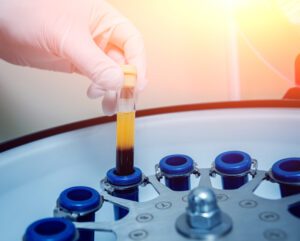What is PRP

Platelet-rich plasma (PRP) is blood plasma that has been concentrated with your platelets. As a concentrated source of autologous platelets, PRP contains (and releases through degranulation) several different growth factors and other cytokines that stimulate healing of bone and soft tissue.
Platelets are a specialized type of blood cell involved in injury healing. Platelets also contain large reservoirs of natural growth factors that are essential for the cell recruitment and multiplication involved in wound healing. The normal concentration of platelets circulating in our blood is 200,000 per microliter. Current evidence suggests that platelet count in Platelet Rich Plasma should be near or exceed 1,000,000 platelets per microliter which is a concentration of 5x. PRP is made in the office using a centrifuge that separates the blood components and allows us to discard unwanted elements from the blood and to keep the platelets, growth factors, cytokines, and plasma that are used for PRP. The centrifuge takes less than 10 minutes to concentrate the platelets after blood is drawn from the patient.
What growth factors and cytokines are in PRP?
Some of the growth and healing factors found in PRP include:
- Platelet Derived Growth Factor (PDGF)
- Fibroblast Growth Factor (FGF)
- Vascular Endothelial Growth Factor (VEGF)
- Interleukin 8 (IL-8)
- Transforming Growth Factor Beta (TGF-b)
- Insulin like Growth Factor 1, 2 (IGF-1,2)
- Epidermal Growth Factor (EGF)